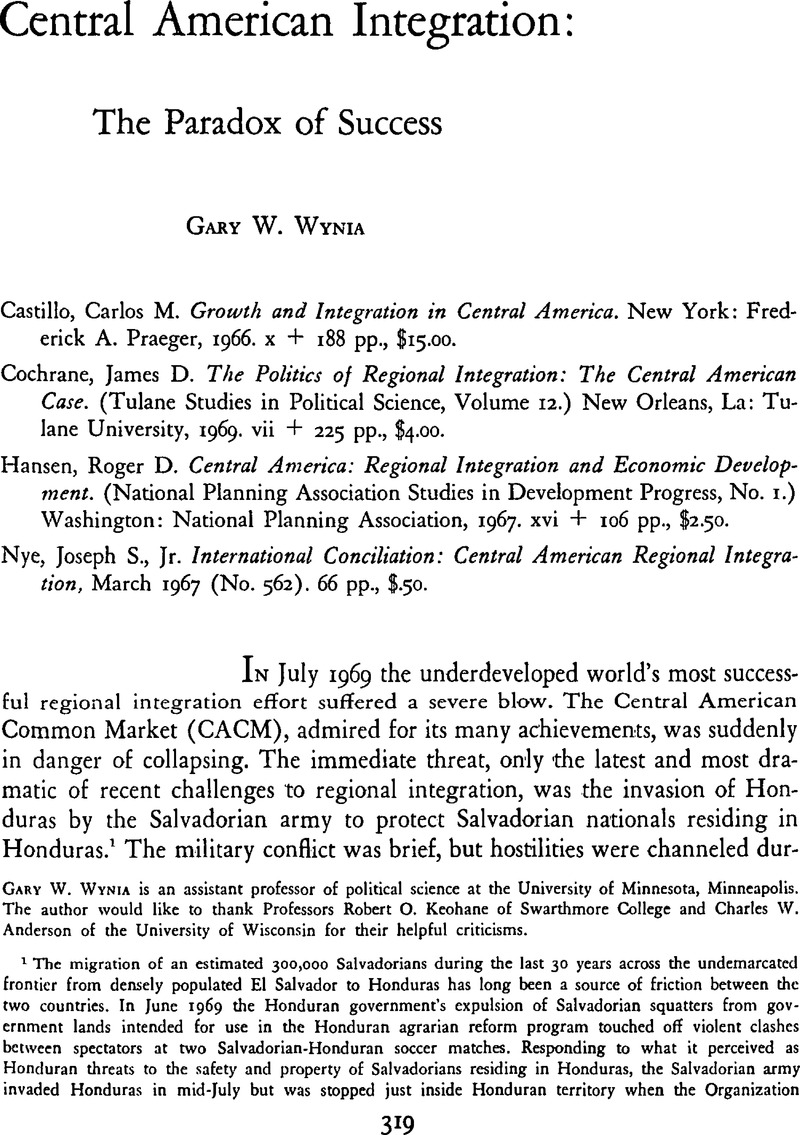Article contents
Central American Integration: The Paradox of Success
Review products
Published online by Cambridge University Press: 22 May 2009
Abstract

- Type
- Review Article
- Information
- Copyright
- Copyright © The IO Foundation 1970
References
1 The migration of an estimated 300,000 Salvadorians during the last 30 years across the undemarcated frontier from densely populated El Salvador to Honduras has long been a source of friction between the two countries. In June 1969 the Honduran government's expulsion of Salvadorian squatters from government lands intended for use in the Honduran agrarian reform program touched off violent clashes between spectators at two Salvadorian-Honduran soccer matches. Responding to what it perceived as Honduran threats to the safety and property of Salvadorians residing in Honduras, the Salvadorian army invaded Honduras in mid-July but was stopped just inside Honduran territory when the Organization of American States (OAS) intervened. While the agrarian reform expulsions were the immediate issues, Salvadorian population pressures and Honduran resentment of Salvadorian encroachment on Honduran lands were the underlying causes of the clash.
2 The Inter-American Highway, El Salvador's principal link with Nicaragua and Costa Rica, traverses a small section of southern Honduras. El Salvador's vulnerability to the Honduran trade embargoes is readily apparent. During 1968 El Salvador, Central America's leading intraregional trader, exported $84.7 million in goods to Common Market nations while importing only $67.5 million; in 1968 it enjoyed a favorable trade balance with Honduras of $8.1 million and from Honduras it purchased much of its staple food.
3 In Latin American integration and political development literature the term “tecnicos” is frequently used when referring to the economists and engineers in the ministries of economy, planning agencies, and other agencies concerned with public finance and economic development.
4 These include the Central American Bank, the Central American Clearing House, the Institute for Research and Technology, and the regional highway and telecommunications programs.
5 On neo-functionalism see, in addition to Nye, and Cochrane, , Haas, Ernst B., The Uniting of Europe: Political, Social, and Economic Forces, 1950–1957 (Stanford, Calif: Stanford University Press, 1958)Google Scholar and Haas, Ernst B. and Schmitter, Philippe C., “Economics and Differential Patterns of Political Integration: Projections about Unity in Latin America,” International Organization, Autumn 1964 (Vol. 18, No. 4), PP. 705–737CrossRefGoogle Scholar.
6 Nye, J. S., “Patterns and Catalysts in Regional Integration,” International Organization, Autumn 1965 (Vol. 19, No. 4), pp. 870–884CrossRefGoogle Scholar.
7 Hansen, Roger D., “Regional Integration: Reflections on a Decade of Theoretical Efforts,” World Politics, 01 1969 (Vol. 21, No. 2), p. 270CrossRefGoogle Scholar.
8 Schmitter, Philippe, “The Process of Central American Integration: Spill-Over or Spill-Around?” paper delivered at the American Political Science Association convention in Chicago, 09 1967Google Scholar.
9 Cochrane, drawing on Nye's work, devotes most of two chapters (7 and 8) to an elaboration of Nye's four explanatory conditions.
10 For a discussion of the development ideologies and policies of the Central American governments during this period see Anderson, Charles W., Politics and Economic Change in Latin America (Princeton, N.J: D. Van Nostrand, 1967), pp. 231–306Google Scholar.
11 The dismal fate of the Central American planning agencies after 1963 is revealed in the annual “country reviews” made by the Inter-American Committee of the Alliance for Progress (CIAP).
12 OEA, El avance de la integration centroamericana y las necesidades de financiamento externo (OEA/Ser H/XIV, CIAP/274) (Washington, 07 1968), p. 46Google Scholar.
13 Almond, Gabriel A. and Powell, G. Bingham, Comparative Politics: A Developmental Approach (Boston: Little, Brown and Co., 1966)Google Scholar.
- 5
- Cited by


